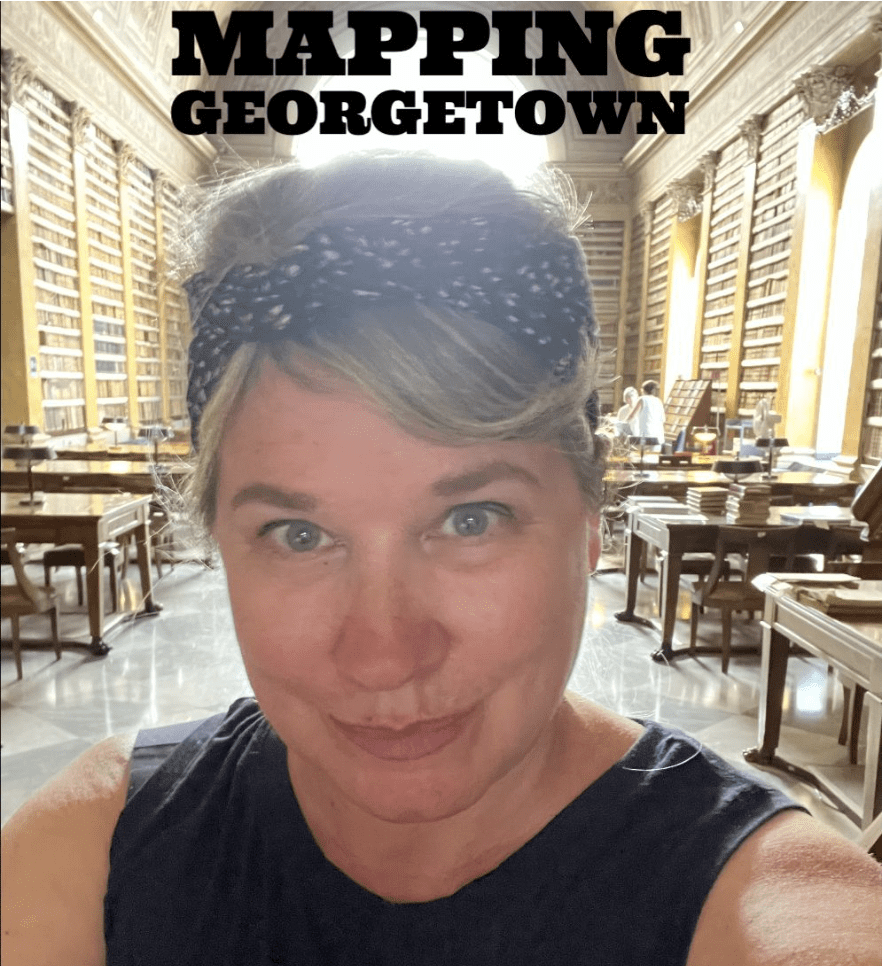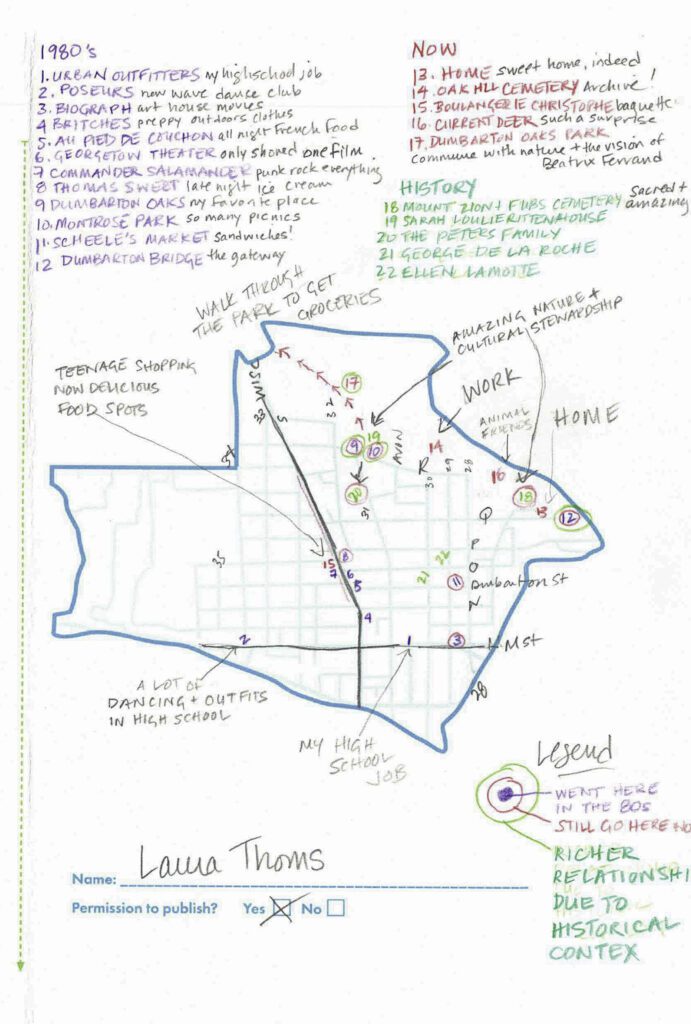Mapping Georgetown: Archivist Breathes New Life into Oak Hill Cemetery
By • March 27, 2023 0 3148

Georgetown’s historic Oak Hill Cemetery at 3001 R Street NW tends to attract all sorts of souls, among both the living and the departed.
The cemetery’s “Changing of the Guard” — Arlington Cemetery has stiff competition — brought Paul Williams, the subject of our last Mapping Georgetown story, to Georgetown. And Williams’s generous spirit overseeing Oak Hill Cemetery continues to attract similar gems for our local history project.
Perhaps the cemetery’s most notable visitor was our 16th president, Abraham Lincoln who visited the body of his son Willie in the Carroll Mausoleam repeatedly in 1862, even requesting Willie’s casket be opened so he could grieve and be closer to his departed child at the height of the Civil War. George Saunders’s best-selling novel “Lincoln in the Bardo” (2017) has brought many visitors to walk Lincoln’s grieving steps here.

After Willie Lincoln’s death from Typhoid fever in 1862, he was placed in the Historic Oak Hill Cemetery Chapel, he was later transferred to the Carroll Mausoleum, then onto the funeral train with his father. His final resting place is Springfield, Illionois with his father, President Abraham Lincoln. Wikimedia.
This week, we’re delighted to introduce another ‘Gem of Georgetown,’ Laura Thoms, project archivist for Oak Hill Cemetery. Many Thanks, Laura, for sharing your experience, expertise, and bright light with us. Surely President Lincoln and so many buried at Oak Hill Cemetery would love to have the experience of a moment of your time and gentle caring personality. I’m sure you bring your spirit to all of these souls and they to you!
Laura Thoms’s Background and Mapping Georgetown Story

Laura Thoms grew up in Potomac, MD, moved to D.C. during high school, and moved back to the U Street Corridor after college at Sarah Lawrence. In the early 2000s she moved to Austin, Texas and in 2017 her employer moved her to the Davis Mountains in West Texas. She is a letterpress printer, bookbinder and has studied book and paper conservation at the University of Iowa Center for the Book, Harry Ransom Center, Rutgers University and has been a resident at Penland. In West Texas she worked on the collections of 1919 Porvenir Massacre witness Harry Warren at the Archives of the BIg Bend, as well as on an interpretation from the archive of Donald Judd’s Chinati Foundation. She is a member of the Washington Conservation Guild and the Society of American Archivists. Her favorite place (other than Georgetown) is Tipoteca Italiano in Cornuda, Italy: the working museum of print and type design of Italy. Summers find her there for a few weeks researching type history, book structures and enjoying all the prosecco.
Walking through time in Georgetown.
In 2021, I moved back to my hometown of Washington, DC, a year and a half earlier than expected. I had been living and working at the McDonald Observatory in West Texas, near Marfa. I could see the Milky Way from my porch, and could look through huge telescopes any night of the week. I ran events and fundraising campaigns aligned with dark skies advocacy, and worked on finishing my Master’s in Archives and Preservation.
Living on top of a remote mountain with 70 of my colleagues and a bunch of wild animals seemed like a desirable place to go through a pandemic – but 3 hours away from a hospital and an airport, I was concerned I would not see loved ones again. Though I was living a Disney-like fantasy of having breakfast every day with a friendly wild deer named Lily, and watching hundreds of hummingbirds rest in my yard each summer during their migration, I yearned to see people — even just strangers walking down the street. In January 2021, during pre-vaccination pandemic, I packed up my cats and my espresso pot and drove 3 days across the country, a day ahead of a snowstorm, and landed back in the home of my heart: Washington, DC.
I knew where I wanted to live. When I lived in the city previously, I lived in hip neighborhoods just east of here– and a trip to Georgetown was always a green respite. As a teenager, I hung out in Georgetown in its waning days of being the cool place for young people to gather. My high school job was at Urban Outfitters on M by 31st, and my friends all worked on Wisconsin Ave: Betsey Johnson, Commander Salamander, Olsson’s Books & Records. Weekends might find us seeing music at Georgetown University, the Bayou, dancing at Poseurs or hanging out on the Exorcist Stairs. Snacks came from Sheele’s Market, Thomas Sweet. The first time I ever saw Dumbarton Oaks was hopping over the fence at midnight as a foolish kid, at the suggestion of my friends to “go swimming.” I thought we were hopping the fence at a neighborhood pool. I dropped to the other side and felt like Alice in Wonderland. I have been entering through the front gates with reverence and respect ever since. It’s funny to live so close to the Buffalo Bridge when a framed poster of the bridge by my friend Jeff Nelson has graced the walls of every place I lived since the 90s. I realized recently how many photos with friends from my teenage years take place a few blocks away from where I now live.
I am always in conversation with the past. I have had a long career in libraries, museums and special collections. My passion is the preservation of the past for future use. When I first returned to DC, I worked in the Conservation Division of the Library of Congress treating and rehousing books and paper materials. A few months ago, I became the Project Archivist for the newly-established archive at Oak Hill Cemetery where I am organizing, conserving, and digitizing papers and photographs dating back to the 1850s. I joined the most wonderful team of historic and environmental stewards, and have delighted in being connected with so many wonderful organizations like the Black Georgetown Foundation, Friends of Montrose Park, Dumbarton Oaks Parks Conservancy, Tudor Place, and Peabody Reading Room at the Georgetown Neighborhood Public Library. I have learned so much about early Georgetown and am learning more everyday through the documents, stories, research and advocacy.
Moving to Georgetown gave me all the vibrant daily life, wonderful neighbors and adorable dogs to pet that I so-badly needed in 2020. It has also given me some unexpected gifts. Walking in this neighborhood is meditative – a mediation between past and present, a kind of falling through time. I love that I pick up baguettes next to where Commander Salamander was located. I text high school friends photos of Thomas Sweet when I’m out running errands, and they will make me take a detour to find out what is now where our beloved Au Pied du Couchon was located. I giggle that the Georgetown Theater that showed Caligula for years, where all the punk boys were ticket takers, is now a Compass Coffee. I learned to love art house films at the Biograph and have a hard time going in the CVS on M Street because it makes me mad that I can’t walk over and see a classic movie there. I was surprised and delighted to discover the occasional deer in Oak Hill Cemetery. I will never go on walks with them as I did with Lily, but I am glad to be connected so closely again to the birds and wildlife that I valued so much in my time in West Texas. Though it was designed in 1849, Oak Hill Cemetery, like all rural garden cemeteries, still embodies a connection to a beautiful pastoral past.
The archival work at Oak Hill allows me to go further back in time when I walk the neighborhood: layering my 1980s memories with stories from 150 years earlier. I will route a trip to pick up dinner so I can check out a place that is connected to a person I am learning about in the Oak Hill Archive. I love that every block offers a conversation with the past. A running history accompanies me on my walks: of families, joy, architecture, community and the difficult legacies of loss, injustice, war, displacement, and grief. Around each corner there may be a garden to admire, a house with fantastic gables, the memory of a great date, a wonderful dinner, or a friend lost too soon. My walks are filled with decades of stories of artists, authors, spies, soldiers and diplomats, but also with stories of my own friends and family.
When I eat my lunch in Montrose Park, I love to think about how the land has changed — in 2023, in 1993, and even in 1823. While I’m walking I often think of Georgetown walkers 150 years from now, and wonder what they will look at with curiosity and reverence. As an archivist and lover of history, I often wonder how we can best continue to steward this history, raise up voices from the past that have not yet been heard, and engage with new audiences, while broadly collecting the stories that are happening every day. I am honored to become part of this conversation myself via this beautiful community-sourced history map of Georgetown, and thrilled to be a part of preserving the legacy of Oak Hill Cemetery. Every day I find something new, old or unexpected while I go about my day in Georgetown. I am looking forward to continuing the conversation with all of you.
Stop by and say hello at Oak Hill Cemetery gate house on the weekends or shoot me an email at archives@oakhillcemeterydc.org
—-
These Mapping Georgetown stories can be viewed in full at https://mappinggeorgetown.com/2021/11/01/day-of-the-dead-andrea-seiger/.
We invite you to add your story to our Mapping Georgetown collection. Blank templates can be printed from the home page of www.mappinggeorgetown.com or picked up from The Georgetown Public Library.
To learn more about the Mapping Georgetown project see https://georgetowner.com/articles/2021/07/19/marilyn-butlers-vision-for-mapping-georgetown/. Marilyn Butler can be reached at marilyn.butler@gmail.com

